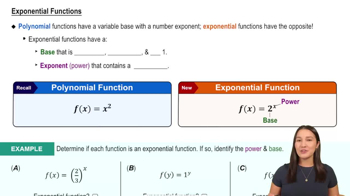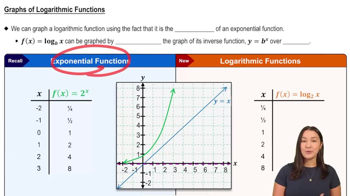Convert the following exponential expression to its equivalent logarithmic form.
Table of contents
- 0. Functions7h 54m
- Introduction to Functions16m
- Piecewise Functions10m
- Properties of Functions9m
- Common Functions1h 8m
- Transformations5m
- Combining Functions27m
- Exponent rules32m
- Exponential Functions28m
- Logarithmic Functions24m
- Properties of Logarithms36m
- Exponential & Logarithmic Equations35m
- Introduction to Trigonometric Functions38m
- Graphs of Trigonometric Functions44m
- Trigonometric Identities47m
- Inverse Trigonometric Functions48m
- 1. Limits and Continuity2h 2m
- 2. Intro to Derivatives1h 33m
- 3. Techniques of Differentiation3h 18m
- 4. Applications of Derivatives2h 38m
- 5. Graphical Applications of Derivatives6h 2m
- 6. Derivatives of Inverse, Exponential, & Logarithmic Functions2h 37m
- 7. Antiderivatives & Indefinite Integrals1h 26m
- 8. Definite Integrals4h 44m
- 9. Graphical Applications of Integrals2h 27m
- 10. Physics Applications of Integrals 3h 16m
- 11. Integrals of Inverse, Exponential, & Logarithmic Functions2h 34m
- 12. Techniques of Integration7h 41m
- 13. Intro to Differential Equations2h 55m
- 14. Sequences & Series5h 36m
- 15. Power Series2h 19m
- 16. Parametric Equations & Polar Coordinates7h 58m
0. Functions
Logarithmic Functions
Problem 1.35
Textbook Question
Find the inverse f−1(x) of each function (on the given interval, if specified).
f(x)=e2x+6
 Verified step by step guidance
Verified step by step guidance1
Start by setting the function equal to y: y = e^{2x + 6}.
To find the inverse, swap x and y: x = e^{2y + 6}.
Solve for y by taking the natural logarithm of both sides: \ln(x) = 2y + 6.
Isolate y by first subtracting 6 from both sides: \ln(x) - 6 = 2y.
Finally, divide both sides by 2 to solve for y: y = \frac{\ln(x) - 6}{2}. This is the inverse function, f^{-1}(x).
 Verified video answer for a similar problem:
Verified video answer for a similar problem:This video solution was recommended by our tutors as helpful for the problem above
Video duration:
3mPlay a video:
Was this helpful?
Key Concepts
Here are the essential concepts you must grasp in order to answer the question correctly.
Inverse Functions
An inverse function reverses the effect of the original function. If a function f takes an input x and produces an output y, the inverse function f^{-1} takes y back to x. For a function to have an inverse, it must be one-to-one, meaning each output is produced by exactly one input. This property ensures that the inverse function is well-defined.
Recommended video:

Inverse Cosine
Exponential Functions
Exponential functions are of the form f(x) = a * e^(bx), where e is the base of natural logarithms, approximately equal to 2.71828. These functions grow rapidly and are characterized by their constant rate of growth proportional to their current value. Understanding their behavior is crucial for finding inverses, especially since the inverse of an exponential function is a logarithmic function.
Recommended video:

Exponential Functions
Logarithmic Functions
Logarithmic functions are the inverses of exponential functions and are expressed as f^{-1}(x) = log_a(x) when the base is a. They help solve equations where the variable is an exponent. The properties of logarithms, such as the product, quotient, and power rules, are essential for manipulating and simplifying expressions when finding inverses of exponential functions.
Recommended video:

Graphs of Logarithmic Functions

 7:3m
7:3mWatch next
Master Logarithms Introduction with a bite sized video explanation from Patrick
Start learningRelated Videos
Related Practice
Multiple Choice
198
views
2
rank
